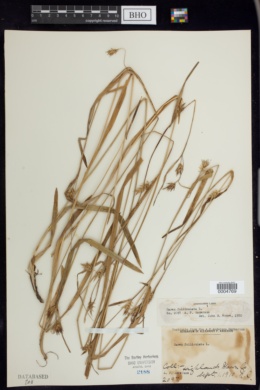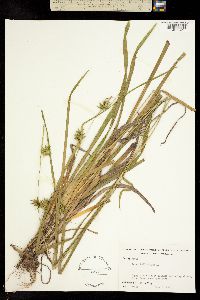Carex folliculata
|
|
|
|
Family: Cyperaceae
Northern Long Sedge
[Carex xanthophysa] |
Culms obtusely trigonous in cross section, (25-)40-175 cm, smooth. Leaves: ligules 2.5-10 mm, as wide as long to wider than long; blades yellowish green to light green, M-shaped to flat, 6-18(-21) mm wide, smooth or sometimes finely papillose and scabrous adaxially, especially distally; widest leaves of vegetative shoots 8-18(-21) mm wide. Inflorescences 15-85 cm; bract sheaths prolonged, apex truncate to convex; proximal 3-5 spikes pistillate (occasionally a few empty scales at apex), erect or the proximal nodding, ovoid to short cylindric. Pistillate scales lanceolate to narrowly ovate, mostly 2/3 as long as to exceeding perigynia, apex acuminate-awned. Anthers 3-5 mm. Perigynia ascending to spreading, yellowish green, 18-26-veined, slightly inflated, lanceolate, 10.3-15.6 × 1.8-3.3 mm, 4-7 times as long as wide, apex gradually tapered, bidentulate; beak absent. Achenes (3.2-)3.4-4(-4.5) × 1.5-2.3 mm, (1.7-)1.8-2.4 times as long as wide. 2n = 56. Fruiting late spring-summer. Wet forests, bogs, seeps, wet meadows, marsh edges, stream banks, lakeshores, in acidic, sandy, or peaty soils; 0-1800 m; St. Pierre and Miquelon; N.B., Nfld. and Labr., N.S., Ont., P.E.I., Que.; Conn., Del., D.C., Ga., Ind., Maine, Md., Mass., Mich., N.H., N.J., N.Y., N.C., Ohio, Penn., R.I., S.C., Tenn., Vt., Va., W.Va., Wis. South of central Virginia, Carex folliculata occurs only in the Appalachian mountains. Clumps of C. folliculata are striking because of the very broad, yellowish green leaf blades of their vegetative shoots.
Stems to 1 m, forming large clumps; terminal spike staminate, 1.2-2.5 cm, peduncled and often exserted beyond the perigynia; pistillate spikes 2-5, usually strongly separate, erect, subglobose, 1.5-3 cm long and wide, the lowest peduncles elongate, the upper shorter; bracts lf-like, 4-8 mm wide, surpassing the stems, their sheaths prolonged at the mouth into a rounded or truncate lobe; pistillate scales ovate, much shorter than the perigynia, hyaline or brown-tinged with green midstrip, the body acute or acuminate; perigynia slenderly subulate, 10-15 נ2-3 mm, nearly circular in cross-section, sharply many-nerved, long-attenuate into a stout beak with erect teeth; achene loosely enveloped, concavely trigonous, continuous with the persistent slender style. Wet or swampy woods; Nf. and Que. to Wis., s. to Fla. and La. Var. folliculata, a northern form occurring s. to s. Del., W.Va., and Ind., has the main lvs 6-16 mm wide, the pistillate scales usually rough-awned, the whole scale from two thirds as long to slightly longer than the perigynium, the pistillate spikes occasionally with a few distal staminate fls. Var. australis L. H. Bailey, of the coastal plain from s. Md. to Fla. and La., has the main lvs 4-10 mm wide, the pistillate scales usually long-acuminate, seldom awned, about half as long as the perigynia, the pistillate spikes frequently staminate at the tip; it is perhaps better treated as a distinct species, C. lonchocarpa Mack. Gleason, Henry A. & Cronquist, Arthur J. 1991. Manual of vascular plants of northeastern United States and adjacent Canada. lxxv + 910 pp. ©The New York Botanical Garden. All rights reserved. Used by permission. From Flora of Indiana (1940) by Charles C. Deam Known in Indiana only from the dune area in Porter and La Porte Counties where it is locally frequent on mucky borders of wet woods. One collection of Deam's (4 miles northeast of Michigan City) is from a sedge marsh. ...... Indiana Coefficient of Conservatism: C = 10 Wetland Indicator Status: OBL |































































































